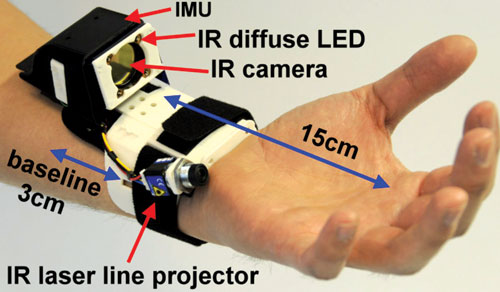Application. The bend sensors are placed on the joints of all the fingers in the data glove, so the more the fingers are bent, the more is the resistance which is introduced in the device for further action.
Infrared proximity sensors. These have the ability to detect the presence of nearby objects without any physical contact. They emit an electromagnetic field and then identify the changes either in the field or in the return signal, which they detect after reflection from an object that has got close to the sensor. There are many types of proximity sensors; however, infrared proximity sensors play a very important role in gesture recognition. As soon as these infrared sensors recognise the movement of a body in front of them, they pass a signal to the device for further action.
Application. Many of us have seen a wash basin with an automated tap. The tap turns on as soon as it senses some hand movement under it. This is because of the presence of infrared proximity sensors that detect your hand movement. Here’s a fun thing to try out—if you keep your hand under the tap without any movement, the tap would not allow the water to fall. This is because if you keep your hand immobile, the sensor does not sense a changing field and thus thinks that your hand is not in front of it any more.
Capacitive proximity sensors. They support gesture recognition enabling robust, easy-to-use and feature-rich user touch interfaces on a device—these are what make up your capacitive touch screen. Such sensors allow users to operate the device just by the touch of their skin or finger rather than by applying pressure. Some of the newer models have superior sensors that do not even require a touch—hovering above the screen is enough to get their attention.
Application. This has helped to bring about a new era of devices with superior touch screens that allow multiple points of input, and better durability. What’s more, capacitive screens allow the device to have a glass or some other rigid protection on top of the touch screen, thus improving the device’s ergonomics.
Touch-sensing controllers, such as the CapSense from Cypress, have specific technical improvements like water tolerant capacitive touch buttons, which eliminates false touches under moist conditions. “They also allow capacitive proximity sensing for up to 30cm, which is instrumental in enabling features such as ‘wake-on approach,’ and can even replace the IR sensors mentioned in the previous section,” explains Anbarasu Samiappan, product apps manager, Cypress Semiconductor.

What’s coming up in the future
I am pretty sure we will see something like Tom Cruise’s sorcery in ‘Minority Report’ within a couple of decades. But until that happens, the field is taking great strides forward.
Researchers have been working on new kinds of hardware to compute gestures, including FPGAs. “Apart from basic components to capture the images, an FPGA-based gesture recognition system handling large computational complexity of optical flow to perform parallel processing is a low-cost solution. Using an FPGA system, gesture recognition can be implemented at 30 frames per second, and the system software can subsequently schedule all tasks during processing,” explains P. Chow Reddy, manager (R&D), Power Division, ICOMM Tele Pvt Ltd.
Apart from the focus in consumer electronics, gesture recognition seems to have matured enough to be noticed and implemented in industrial settings. The BMW Group has demonstrated a gesture-driven system that allows a quality assurance worker to “…examine and document flaws in a component simply by pointing.” Ford had earlier announced its own gesture-based ambitions in the form of ‘a complete virtual factory.’ Industry aside, even Microsoft Office 2013 has gesture recognition built into it.
At Electronics Rocks‘13 conference, one of our speakers Hemant Surale showcased a cool smart glove product that he had designed. Hemant says that the present scenario in gesture recognition seems that development in this area is at its peak. “Most of the devices comes with their own proprietary SDKs for application developers. In addition there are many emerging startups developing effective way to interact with day to day equipments. But, Internet of things will present new challenges with respect to integration of such systems into day to day life of users.” Hemant is also an active member of the IoTBLR community. IoTBLR is a community based in Bangalore, which is excited about connecting disparate devices to one another via the web to create Internet of Things products. Any engineer can find them on facebook at facebook.com/groups/IoTBLR
The field of gesture recognition seems to be gearing up for quite a future, and design houses working on this technology better get ready for the competition that comes with any high-profile industry.
Sneha Ambastha is a tech journalist at EFY Delhi and Dilin Anand is senior tech correspondent at EFY Bengaluru







Fantastic work by sneha ambastha ,this article was definitely very much helpful thank you EFY
Thank you Rishabh for your valuable comment.